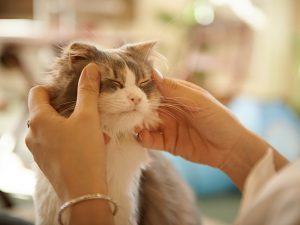Pet Massage Therapy. In the first of our four-part series on luxurious pet services, we delve into the world of pet massage therapy–what it is, why it’s important, and tips for pet parents considering massage therapy for their furry friend – by Caroline Wilson, owner/head editor & writer of /redpen.
We’ve all been there. Sore and exhausted after exercise, stressed after a long week of work, or just drained. Maybe your feet are killing you after a day of walking, or your shoulders and back ache from sitting at your desk all day. Regardless of the source, we’ve all felt pain, and I’m sure we’ve all wanted a massage at one point for said pain. Well, our pets apparently feel the same way–and there are pet massage therapists to help them.
I always thought that just petting dogs and cats was technically a massage, but pet massage therapy is far more than the gentle patting on the head you give Rover after he fetches his ball. It’s a serious profession–just like that of a human massage therapist. The animals that receive these treatments are most commonly dogs, cats, and horses. These services are growing in popularity, and for good reason. With rates as low as $35 per hour in some cases, you can give your best friend more than just a little pampering session.
Animal Massage Care
Massages provide as many benefits to our furry friends as they do to humans. Animals, like us, develop stiffness in their joints from aging or inactivity, which leads to arthritis. They also experience soreness from exertion in the same way we do. “Since animals can’t speak to us in the language we use to speak to each other, holistic healing touch is the next best thing we can implement as a form of communication” says Alexis Justman, a certified canine massage therapist from Sugar Muzzles (an LA-based company specializing in dog massages). Regular massage therapy throughout your pet’s life can help alleviate those pains. Like any human massage, they can also improve body function (for example, massages can increase flexibility and good blood circulation) and boost moods while indulging your pet.
Justman doesn’t consider hers to be a luxury pet service. Her hope is that massages “will be accessible to all pets from all walks of life, and pet parents will find a way to integrate massage into their animal’s wellness routine.” Her practice focuses on “underdogs”–homeless, elderly canines that suffer or have suffered from illness or abuse. She says that these dogs are those who need it the most.

The Massage Process
So what goes into animal massage? Surprising, a lot-comparable to that of a human massage. The process starts with intake paperwork (an overview of your critter’s medical history). Many therapists also meet their clients before the session to set up a bond with the animal. The massage begins with some petting in the areas they’re going to be focusing on in order to warm up the muscles. After that, the therapist will practice a variety of techniques specific to your pet. For example, a therapist working a cat might perform a “voice massage”, repeating a comforting phrase to the feline in order to relax her. Horse massages will often include an ear rub to relieve tension. These techniques, along with others, are known to elicit positive responses from the animals in question. Most therapists will also teach you a few moves so that you can also ease your pet’s tension in between sessions.
However, not everyone loves massages, and similarly, neither will all pets. Some dogs and cats may be more skittish than others, and in that case, a massage might do more harm than good. It’s imperative to make sure your pets are comfortable with receiving a massage. In addition, animals with certain medical conditions might feel more pain than pleasure from a massage session.
Licensed Care
It’s also important to make sure that your critters are in the hands of a qualified animal masseuse, the definition of which varies from state to state. Some states only allow veterinarians to practice animal massage therapy, but then again, some states don’t even regulate licensing in human massage therapists. Justman’s 200-hour certification process, which took place at the Ojai School of Canine Massage, was very thorough, requiring rigorous training, studying, exams, thesis presentation, and logged hours of application and practice. California is one of the states that doesn’t limit the practicing of animal massage to veterinarians, which makes the service a common one in the LA area.
“People [in LA] tend to be more open-minded and willing to explore alternative and holistic care to either replace or supplement their existing wellness routine” says Justman on the popularity of her services in her location. The growing presence of mindfulness in health has also contributed to pet massages becoming a more common practice.

Did you find this article useful? Would you like 100% free access to more articles like these, and free access to over 5,000 vetted pet care service professionals throughout the United States? Sign up here for a free Petworks account, and take 10% off your first booking, on us!
If you’re considering booking a massage session for your pet, make sure that you contact a reputable therapist. The Petworks pet care services platform has tons of options for you and your furry friend.
In our next article, we’ll be talking about pet event planners and how throwing puppy parties are beneficial to your pet and you.
About our professional:

Alexis Justman is a certified canine massage therapist based in Los Angeles, California. After helping one of her foster dogs battle cancer with various alternative and holistic methods of care, she wanted to give relief to senior dogs in pain. That’s how she found the Ojai School of Canine Massage, a well-recognized program established in 1999. In 2016, Justman received her certification and founded Sugar Muzzles. She works with “underdogs”–homeless, elderly canines that suffer or have suffered from illness or abuse. She encourages all pet parents to consider bringing elderly rescues into their lives–they need and give love the most.
 In 2021, Dr. Marty Goldstein DVM joined the pet care platform Petworks as an advisor in its Animal Nutrition care division. Dr Marty Nature’s Blend is on a mission to help your pets live their healthiest lives possible. Dr. Marty’s pet nutrition expertise and guidance has helped Petworks evolve and become the preeminent animal and pet nutrition consultation service for pet parents in North America.
In 2021, Dr. Marty Goldstein DVM joined the pet care platform Petworks as an advisor in its Animal Nutrition care division. Dr Marty Nature’s Blend is on a mission to help your pets live their healthiest lives possible. Dr. Marty’s pet nutrition expertise and guidance has helped Petworks evolve and become the preeminent animal and pet nutrition consultation service for pet parents in North America.
 In 2022, Blue Buffalo Founder Bill Bishop Jr. joined Petworks as Senior Advisor in our Animal Nutrition Care Division. Bill brings his extensive expertise in pet food innovation and business leadership. His guidance helps Petworks enhance our pet nutrition service offerings, helping to ensure that pet parents throughout the world receive trusted, science-backed nutritional support for their dogs, cats, and animals.
In 2022, Blue Buffalo Founder Bill Bishop Jr. joined Petworks as Senior Advisor in our Animal Nutrition Care Division. Bill brings his extensive expertise in pet food innovation and business leadership. His guidance helps Petworks enhance our pet nutrition service offerings, helping to ensure that pet parents throughout the world receive trusted, science-backed nutritional support for their dogs, cats, and animals.
 Petworks Co-Founder Kevin Kinyon is a life-long animal lover who works tirelessly to improve the lives of pets and their parents. Human and animal qualities he values most are integrity, humor, and empathy.
Petworks Co-Founder Kevin Kinyon is a life-long animal lover who works tirelessly to improve the lives of pets and their parents. Human and animal qualities he values most are integrity, humor, and empathy.



Good content again!